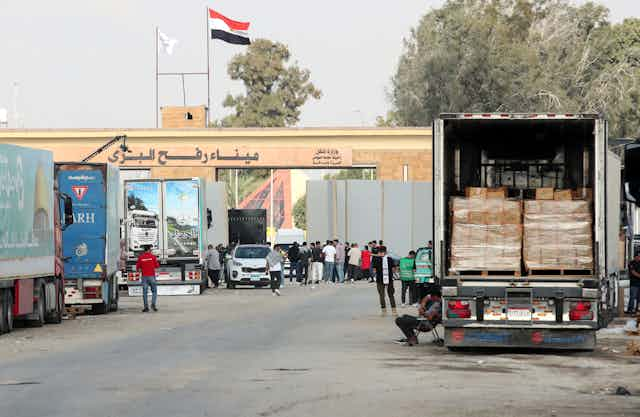In his State of the Union address, Joe Biden announced an idea to alleviate the desperate humanitarian situation in Gaza. The American president said he is “directing the US military to lead an emergency mission to establish a temporary pier in the Mediterranean on the Gaza coast that can receive large ships carrying food, water, medicine and temporary shelters”.
Hopes of a humanitarian ceasefire, which seemed within reach only recently, have dwindled once again as both Israel and Hamas have doubled down on their incompatible positions. So Biden’s announcement represents the latest desperate attempt to get around the Israeli blockade that severely limits the flow of supplies into Gaza.
The number of trucks going through the two opened border crossings has been particularly low lately – with an average of 100 trucks a day in February to supply millions of people.
More aid is desperately needed. Children are dying of malnutrition and dehydration in Gaza. Overcrowded shelters offer very little space and most people in Gaza live with limited access to water and poor sanitation facilities. The few operational hospitals are struggling with a lack of staff, electricity and medical supplies.
Recent air drops by the Jordanian and US air forces and now Biden’s plans for a pier for aid deliveries may look spectacular, but they can have only limited impact.
Air drops are an option of last resort, delivering very few supplies at high cost. Meanwhile, sea transport can handle large volumes at reasonable costs, so opening a sea route would be beneficial.
But any cargo reaching Gaza on this route would encounter the same issues that are plaguing humanitarian deliveries by road. The Israeli blockade requires strict checks on goods, which in the new maritime channel will be carried out in Cyprus.
In a joint statement, the European Commission, Cyprus, the UAE, the US, and the UK stressed that “efforts will be closely coordinated with the Government of Israel”.
As humanitarian logistics researchers who have been following the Gaza response of the Logistics Cluster, the coordination mechanism of a number of humanitarian agencies, we believe a workable plan for aid logistics in Gaza should include the following points.
1. Safe access guarantee
All parties need to agree to ensure the safety of humanitarian convoys. Aid, no matter how it arrives, needs to be distributed to the population. Aid organisations are warning that attacks on humanitarian workers make their work nearly impossible.
Aid convoys have come under fire from Israel and are denied access to those in need. As a result, Palestinian police have become hesitant to escort aid deliveries.
Receiving aid can also be deadly. In the recent so-called “flour massacre”, at least 112 Palestinians died as they gathered to collect basic food aid. UN peacekeepers should be allowed to provide protective escorts for aid convoys.
2. Eliminate bottlenecks
More entry points into Gaza need to be opened. The planned pier is a step in the right direction, but it will take weeks to be operational. Opening more road crossings would be much faster and alleviate pressure on the two operational crossings, Rafah and Kerem Shalom.
At the moment, aid deliveries encounter long waits at checkpoints. In Gaza, roads need to be open and any checks on humanitarian workers and their cargo minimised to limit delays.
Trucks being held for hours at Israeli military checkpoints can mean they don’t reach areas further away from the border crossings and have to turn back. This has resulted in looting by desperate Palestinians.
3. Access to northern Gaza
Humanitarian aid has to be delivered to all parts of Gaza, but access to the north has been particularly challenging. Humanitarian operations to the north were halted on February 5 after a UN-coordinated food convoy was hit by Israeli naval fire and humanitarian workers reported intimidation by soldiers at an Israeli checkpoint.
Opening a border crossing giving aid convoys access to the northern part of Gaza is currently being discussed between the USA and Israel. The UN is also exploring the use of an Israeli military road along the border fence to get aid to the north and checking new potential routes to make sure they are free of unexploded ordnance.
4. Restricted items
Not all humanitarian supplies are allowed into Gaza. Items are restricted, especially where Israel is citing concerns about potential use by Hamas. Various items, including filtration systems and even sleeping bags, have been blocked while others have been stuck in bureaucratic limbo, waiting weeks for clearance.

Even with clearance, there is no guarantee items will be allowed into Gaza. To scale up humanitarian aid, restrictions have to be lifted. Rules need to be clear and consistent. Allowing sufficient quantities of fuel to enter is critical to operate trucks, hospital equipment and water-purification plants.
5. Humanitarian visas
Humanitarian work also requires humanitarian workers. While many are local staff, international personnel are also essential for such a large-scale aid effort. Recently, Israel has ceased issuing visas for international humanitarian personnel working in the Palestinian territories.
Dozens of international humanitarian workers have left, while some are risking deportation by outstaying their visa limits. At least 99 humanitarian workers’ visas have either expired or will expire in the next six months. This is impeding endeavours to deliver essential supplies to Gaza.
6. Commercial trade
In the longer term, it is both impossible and undesirable to support a population as large as Gaza’s entirely through humanitarian aid. It is important that the movement of goods also includes the resumption of trade to complement the humanitarian response.
Currently, there is very limited commercial traffic across the border. But a functioning local market is paramount for any prospects of economic recovery in Gaza.
A minimum target for trucks entering Gaza every day should be the pre-war average of 500. Given the scale of destruction and destitution, the aim for combined traffic of commercial vehicles as well as those operated by the United Nations and other non-government organisations should now be even higher.

